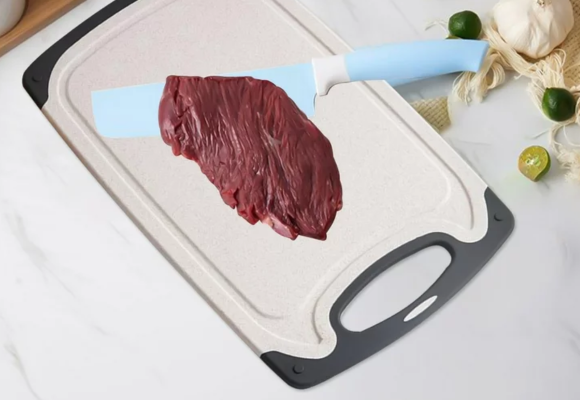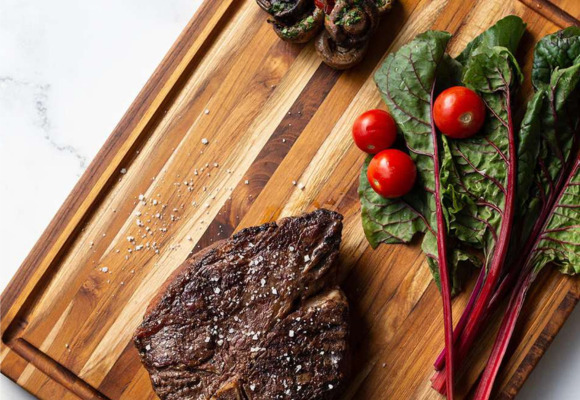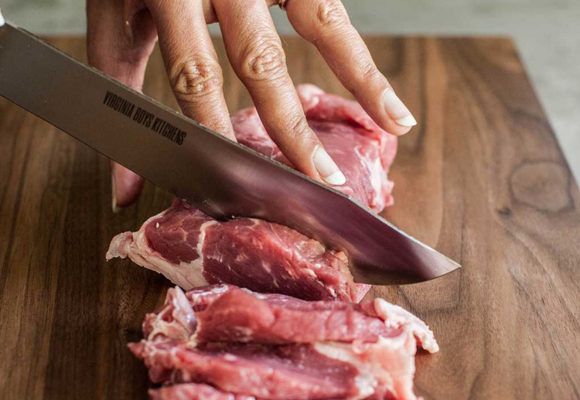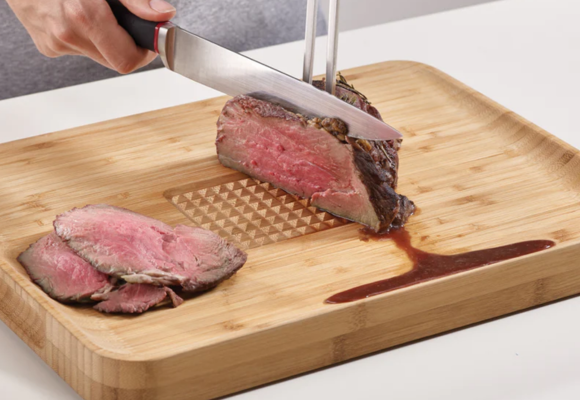Each material offers distinct benefits and considerations in terms of hygiene, durability, and impact on knives.
When selecting a cutting board for meat preparation, the choice between wood and plastic is crucial.
Wood cutting boards, known for their natural aesthetic and self-healing properties, offer a traditional choice that can be kinder to knives.
However, they require more maintenance to prevent warping and cracking. On the other hand, plastic cutting boards are lightweight, affordable, and easy to clean, often being dishwasher-safe. Yet, they can be harsher on knives and might harbor bacteria in grooves from knife cuts.
This discussion aims to explore both wood and plastic cutting boards, offering insights to help you make an informed decision based on your cooking habits, health concerns, and personal preferences.

Wood Or Plastic Cutting Board For Meat – Which Is Best?
When it comes to preparing meat, choosing the right cutting board is crucial for both hygiene and the longevity of your kitchen tools. The debate between wood and plastic cutting boards has long been a topic among culinary enthusiasts and professionals. While plastic boards are often praised for their ease of cleaning, wood boards are lauded for their durability and natural aesthetic. This article delves into the pros and cons of each type, focusing on aspects such as food hygiene, maintenance, and suitability for different types of food.
Food Hygiene
Ensuring food hygiene is critical in any culinary environment, particularly when it involves handling and preparing meat. The material of the cutting board you choose plays an integral role in maintaining hygiene standards. Factors like the board’s ability to harbor bacteria, ease of cleaning, and reaction to knife cuts are essential considerations.

Antimicrobial Cutting Boards
Cutting boards with antimicrobial properties are designed to inhibit the growth of bacteria, mold, and mildew. Wooden cutting boards, by nature, offer certain antimicrobial qualities. The capillary action of the wood fibers tends to pull bacteria down into the board, where they are deprived of moisture and eventually die. This self-sanitizing property makes wood a preferred material for many food safety experts. In contrast, plastic cutting boards can be infused with antimicrobial agents during manufacturing. However, they lack the natural antibacterial properties of wood. Over time, as plastic boards accumulate knife scars, they can become a breeding ground for bacteria if not properly sanitized.
Preventing Cross-Contamination
Cross-contamination is a significant risk in kitchens, particularly when handling raw meat, poultry, and seafood. Wood cutting boards are less likely to cause cross-contamination because of their ability to absorb liquids. This absorption reduces the likelihood of meat juices spreading, which is a common vehicle for cross-contamination. However, it’s crucial to note that proper cleaning and maintenance are vital to ensure the hygiene of wooden boards.
Plastic boards, being non-porous, don’t absorb liquids. This can be advantageous as it prevents the board from soaking up meat juices. However, the downside is that juices can pool on the surface and spread if not immediately cleaned. The key to preventing cross-contamination, regardless of board material, lies in diligent cleaning practices. This includes using separate boards for different types of food – a practice known as color-coding in professional kitchens. For instance, using a designated board for raw meats and another for vegetables can significantly reduce the risk of cross-contamination.
In addition to choosing the right material, the physical condition of the cutting board is also crucial. Boards with deep cuts and grooves can harbor bacteria and make cleaning more difficult. Regular inspection and replacement of cutting boards that show significant wear and tear are important steps in maintaining kitchen hygiene.
Best Wood for Cutting Board
Not all wood is created equal when it comes to cutting boards. Hardwoods like maple, walnut, and cherry are ideal for cutting boards due to their density and durability. These woods are less prone to scratches and gouges, which means fewer crevices for bacteria to hide. Additionally, the tight grain of hardwoods makes them less absorbent and easier to clean compared to softer woods.

Wooden Chopping Boards Care
How to Sanitize a Wood Cutting Board
Caring for a wooden cutting board is essential for its longevity and hygiene. To sanitize a wooden cutting board, you should clean it with hot, soapy water after each use. For deep cleaning, a solution of vinegar and water can be used to eliminate bacteria without harming the wood. Avoid soaking wooden boards in water or cleaning them in a dishwasher, as this can cause warping and cracking.
How to Choose the Right Cutting Board for Specific Tasks
The type of food you’re preparing should influence the choice of your cutting board.
Meat, Poultry, and Fish
For meat, poultry, and fish, a cutting board that’s durable and easy to clean is essential due to the risk of contamination. Hardwoods are often recommended for their durability and antimicrobial properties.
Fruits and Vegetables
Fruits and vegetables are less demanding, but a smooth, non-porous surface is preferred. Plastic boards can be a good choice here, as they are easy to clean and won’t dull knives quickly.
Bread and Baked Goods
For bread and baked goods, a wooden cutting board can provide a stable, knife-friendly surface. The aesthetic appeal of wood also makes it a preferred choice for serving.
What Type of Oils Are Safe to Use on Your Cutting Board?
Maintaining a cutting board often involves oiling to keep it from drying out and cracking. Food-safe oils like mineral oil, coconut oil, and beeswax are safe and effective for wooden cutting boards. These oils penetrate the wood, preserving its natural look and preventing it from absorbing food odors. It’s important to avoid cooking oils, as they can become rancid and affect the taste of your food.

Is a wood or plastic cutting board better for raw chicken?
When it comes to cutting raw chicken, both wood and plastic cutting boards have their advantages and disadvantages, and the best choice often depends on personal preference and specific kitchen practices.
Wooden Cutting Boards:
- Antimicrobial Properties: Wood has natural antimicrobial properties. Studies have shown that wood can trap bacteria within its fibers and gradually eliminate them, reducing the risk of cross-contamination.
- Knife-Friendly: Wood is gentler on knives, keeping them sharper for longer.
- Maintenance: Requires more maintenance. Wooden boards should not be soaked in water or put in a dishwasher, as they can warp or crack. They also need regular oiling to maintain their condition.
Plastic Cutting Boards:
- Ease of Cleaning: Easier to clean and maintain. Most plastic cutting boards are dishwasher safe, which can be an effective way to sanitize them after cutting raw chicken.
- Durability: While durable, plastic boards can get scratched and gouged over time. These grooves can harbor bacteria, making thorough cleaning essential.
- Non-Absorbent: Plastic doesn’t absorb liquids, which can be both a pro and a con. It prevents the board from absorbing chicken juices but can also lead to these juices pooling on the surface if not cleaned immediately.
In terms of hygiene, both types of boards, if properly maintained, can be safe for cutting raw chicken. The key is to thoroughly clean and sanitize the board after use to prevent cross-contamination. Some people prefer to use plastic for meat because of its ease of sanitization (especially in a dishwasher), while others prefer wood for its natural antibacterial properties and durability.
Final Thoughts
The debate between wood and plastic cutting boards is more than just a matter of preference; it’s a consideration of hygiene, maintenance, and suitability for various culinary tasks. While wood offers natural antimicrobial properties and a classic aesthetic, plastic provides a non-porous, easy-to-clean surface. The choice ultimately depends on individual needs and practices in the kitchen.
It’s important to remember that no cutting board material is inherently superior in all aspects. The key to ensuring food safety and extending the life of your cutting board lies in proper use and care. Regular cleaning, sanitizing, and maintenance, along with mindful practices like using separate boards for different food types, are crucial regardless of whether you choose wood or plastic.
Additionally, understanding the specific needs of the food you’re preparing - whether it’s meat, vegetables, or baked goods - can guide you in selecting the most appropriate cutting board. And when it comes to wooden boards, remember to treat them with the right type of oil to maintain their longevity and hygiene.

